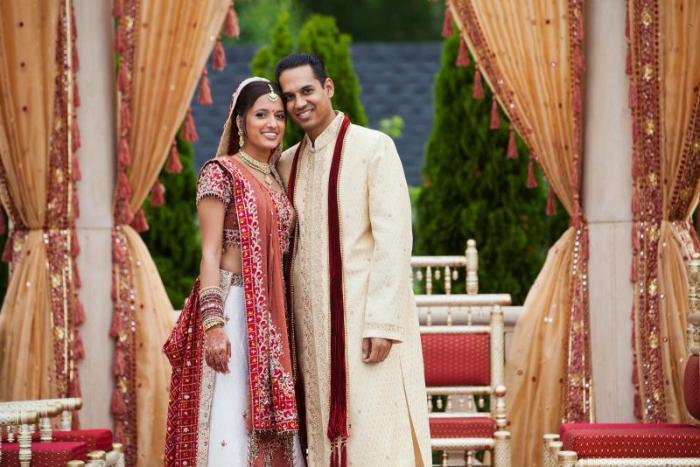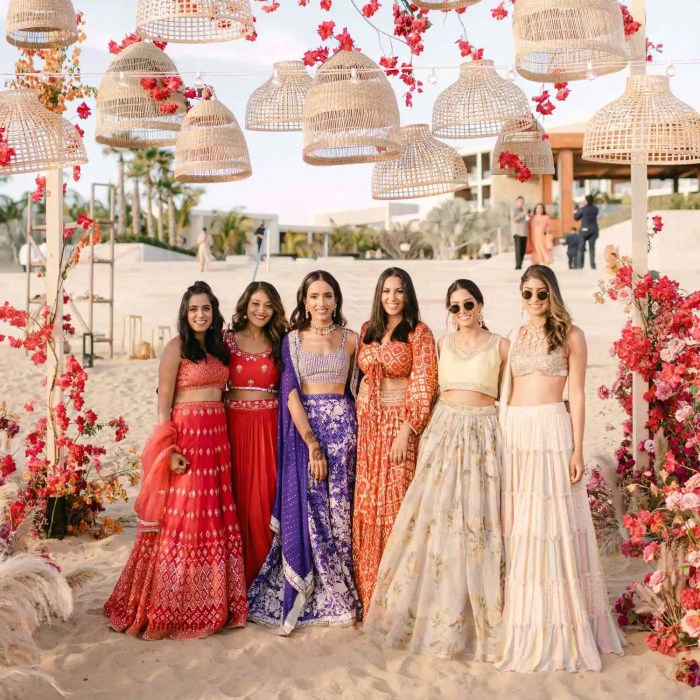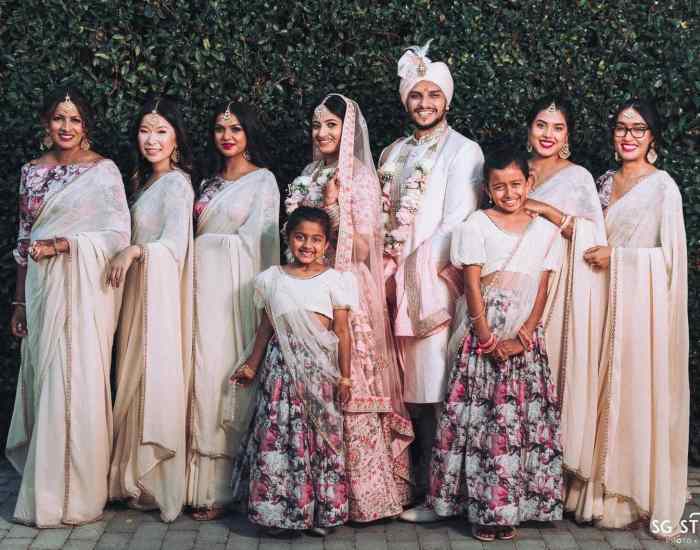Traditional Indian Wedding Guest Dresses A Style Guide
Traditional Indian Wedding Guest Dresses
Choosing the perfect outfit for an Indian wedding as a guest can be an exciting yet daunting task. The vibrant colours, intricate embroidery, and diverse styles offer a vast array of options. This guide provides a comprehensive overview of traditional Indian wedding guest dresses, encompassing various styles, color palettes, accessorizing techniques, modern interpretations, and essential etiquette considerations.
Types of Traditional Indian Wedding Guest Dresses
Indian weddings offer a spectacular display of traditional attire. Several garment types are commonly chosen by guests, each offering unique style and elegance.
- Sarees: The quintessential Indian garment, sarees come in countless variations. Banarasi sarees, known for their opulent gold zari work and intricate silk weaves from Varanasi, are a popular choice for formal weddings. Kanjeevaram sarees, originating from Kanchipuram, are celebrated for their rich, heavy silk and vibrant colours, often adorned with temple border designs. Other silk sarees, like those from Paithani and Mysore, showcase distinct regional weaving techniques and embellishments.
Embellishments range from delicate zari work to heavy embroidery with sequins and beads.
- Lehengas: Lehengas, consisting of a long skirt, a fitted choli (blouse), and a dupatta (scarf), offer a regal and festive look. Fabrics vary widely, from lightweight georgette and chiffon to heavier silks and velvets. Embroidery styles are equally diverse, including intricate zardozi, delicate aari work, and bold gota patti. Design elements can range from minimalist to heavily embellished, depending on the occasion and personal preference.
- Salwar Kameez: The salwar kameez, a more relaxed yet elegant option, comprises a long tunic (kameez) paired with loose trousers (salwar). Variations in cuts, such as the Anarkali style (long, flowing kameez) or the Patiala style (wide-legged salwar), offer diverse silhouettes. Fabrics include cotton, silk, and blends, with embellishments ranging from simple embroidery to intricate mirror work. For weddings, richer fabrics and more elaborate embellishments are preferred.
- Anarkalis and Gowns: Anarkali suits, characterized by their flared, long kameez, and gowns offer a graceful and contemporary take on traditional attire. These styles often feature intricate embroidery, embellishments, and rich fabrics like velvet or silk, making them suitable for wedding celebrations. Gowns can be styled with dupattas or worn without, depending on the overall aesthetic.
| Dress Type | Formality | Fabric Weight | Price Range |
|---|---|---|---|
| Saree | Formal to Semi-Formal | Light to Heavy (depending on fabric) | Variable, depending on fabric and embellishments |
| Lehenga | Formal | Medium to Heavy | Medium to High |
| Salwar Kameez | Semi-Formal to Formal | Light to Medium | Low to Medium |
| Anarkali/Gown | Semi-Formal to Formal | Medium to Heavy | Medium to High |
Color Palettes and Fabrics for Indian Wedding Guest Dresses

Source: ltkcdn.net
Color and fabric choices play a significant role in Indian wedding attire, reflecting both tradition and personal style.
Auspicious colors like red (symbolizing prosperity and good fortune), yellow (representing joy and optimism), and green (signifying new beginnings) are frequently seen. However, a wide range of colors is acceptable, depending on the wedding theme and personal preference. It’s advisable to avoid stark white, which is often reserved for the bride.
- Fabrics: Silk (various types including Banarasi, Kanjeevaram, and others), brocade (known for its rich texture and intricate patterns), velvet (a luxurious choice for cooler weather), and chiffon (a lightweight and flowing fabric) are popular choices. Care instructions vary depending on the fabric; always check the care label before cleaning.
- Embellishments: Zari (gold or silver thread embroidery), gota patti (decorative metallic lace), and aari work (a type of surface embroidery using a hooked needle) are some of the common embellishments used in Indian wedding attire. These add a touch of opulence and sophistication.
A Sample Color Palette:
- For warmer skin tones: Rich jewel tones like emerald green (with silk or velvet), sapphire blue (with brocade), and ruby red (with silk or brocade).
- For cooler skin tones: Pastel shades like blush pink (with chiffon), lavender (with silk), and mint green (with chiffon). Also, deeper colors like navy blue (with velvet) and burgundy (with silk) are flattering.
Accessorizing Traditional Indian Wedding Guest Dresses

Source: brides.com
Accessories are crucial in completing a traditional Indian wedding look, adding a touch of personal style and enhancing the overall aesthetic.
- Jewelry: Traditional Indian jewelry includes necklaces (like the choker, rani haar, or layered necklaces), earrings (jhumkas, studs, or chandelier earrings), bangles (in gold, silver, or other materials), and anklets (payals). The choice of jewelry depends on the outfit and personal preference.
- Hairstyles: Traditional Indian hairstyles often involve braids, buns, or loose curls, adorned with flowers, hair accessories (like maang tikas or jhoomars), or embellished hair clips.
- Footwear: Juttis (traditional Indian footwear), embellished heels, or intricately designed sandals are suitable choices, depending on the outfit and comfort level.
- Other Accessories: Clutches, potlis (small drawstring bags), and dupattas (scarves) add the finishing touches. Dupattas can be draped in various styles, adding another layer of visual interest to the outfit.
A Complete Look Example: Imagine a vibrant red silk saree paired with gold jhumkas, a maang tikka, and a delicate gold necklace. The hair is styled in a neat bun adorned with fresh flowers, and the look is completed with elegant gold juttis.
Modern Interpretations of Traditional Indian Wedding Guest Dresses

Source: getethnic.com
Contemporary designers are constantly reinterpreting traditional Indian garments, blending classic elements with modern sensibilities.
- Fusion Styles: Many designers incorporate Western silhouettes into traditional Indian garments, creating unique fusion styles. For instance, a lehenga skirt paired with a contemporary blouse or a saree draped in a modern style.
- Contemporary Designs: Modern designs often feature asymmetrical cuts, unique draping styles, or unexpected color combinations while retaining the essence of traditional Indian aesthetics.
- Reinterpretation of Traditional Elements: Designers might use traditional embroidery techniques on contemporary silhouettes or experiment with new fabric combinations while preserving the inherent beauty of traditional Indian patterns.
For example, a designer might create a modern Anarkali suit with a high-low hemline, using a contemporary fabric like a silk-blend and incorporating intricate mirror work. Another might present a saree with a unique drape and a contemporary blouse, retaining the traditional fabric but giving it a modern edge.
Choosing attire for an Indian wedding as a guest often involves vibrant colors and intricate designs. The level of formality can vary greatly, depending on the specific event and your relationship to the couple. For inspiration on elegant styles, you might consider looking at the design aesthetic of, for example, a samantha jones wedding dress , though adapting it to a more traditional Indian guest look would be key.
Ultimately, the goal is to find something respectful and celebratory, fitting the joyous occasion.
Etiquette and Considerations for Choosing a Wedding Guest Dress
Choosing a wedding guest outfit requires careful consideration of several factors to ensure appropriate and respectful attire.
- Wedding Type: The formality of the wedding (formal, informal, religious) dictates the level of formality of the attire.
- Cultural Considerations: Respecting the family’s traditions and preferences is paramount. Avoid anything too revealing or overtly flashy.
- Weather and Venue: Choose an outfit suitable for the weather and the venue. A heavy silk saree might be uncomfortable in hot weather, while a lightweight outfit might be inappropriate for a formal evening event.
- Dress Code: Adhere to any dress code specified by the hosts.
Checklist before selecting a dress:
- Consider the wedding’s formality.
- Check the weather forecast.
- Review any dress code instructions.
- Choose an outfit that is comfortable and flattering.
- Ensure the outfit is appropriate for the cultural context.
Key Questions Answered
What is the appropriate dress code for a daytime Indian wedding?
Daytime weddings generally call for lighter fabrics and slightly less elaborate embellishments compared to evening events. Pastel shades and lighter silks or cottons are suitable choices.
Can I wear a Western-style dress to an Indian wedding?
While traditional Indian attire is preferred, a well-chosen Western outfit in rich fabrics and elegant design might be acceptable, especially at less formal events. However, it’s always best to check with the hosts if unsure.
How do I choose a dress that complements my body type?
Consider your body shape and choose a style that flatters your figure. For instance, A-line lehengas are generally flattering, while sarees can be styled to accentuate different features.
Where can I find traditional Indian wedding guest dresses?
Traditional Indian clothing can be found in ethnic wear stores, online retailers specializing in Indian clothing, and even some department stores with dedicated ethnic sections.



















